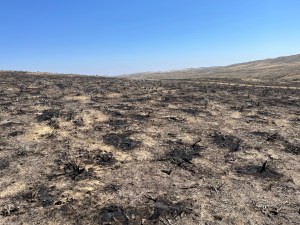The House Draw Fire caused an estimated $25 million in economic damage when it consumed nearly 175,000 acres of mostly private land in Johnson County, a preliminary evaluation found. That figure will almost certainly rise as ranchers in the fire’s path more fully assess their losses and livestock fall ill due to smoke exposure.
While the massive and swift-moving fire did not destroy any homes, it caused extensive damage to local ranching operations including the loss of at least 590 miles of fencing, which alone has a replacement cost of nearly $12 million. Agricultural producers — the land is home to sheep and cattle ranchers — lost storage and water tanks, outbuildings, feed and equipment, among other things.
“These are multigenerational Wyoming ranch families who have been impacted … these burned acres have a story and a face behind them,” said Johnson County Commission Chairman Bill Novotny.
The House Draw Fire burns in Johnson County. (Buffalo Bulletin/Wyoming News Exchange)
The Johnson County Commission included the economic damage estimate in a letter seeking Gov. Mark Gordon’s assistance in obtaining a disaster declaration from the U.S. Department of Agriculture to aid local ag producers affected by the fire. The $25 million estimate only included private property losses and did not factor in damage to public lands or the highway infrastructure along Interstate 90, which the fire crossed as it burned to the north.
The House Draw fire was one of four large blazes that ignited last week in northern Wyoming, charring a combined 450,000 acres.
Lightning ignited the House Draw Fire on Aug. 21, and it exploded in size the following day, running 46 miles — north across Interstate 90 and south down to the Kaycee-Sussex area. About 86% of the land is privately owned, and some ranchers reported losing up to 95% of their acreage to the flames, according to estimates compiled by county officials.
Assessing the damage
The scope of the disaster is already significant, but will almost certainly worsen. The total fencing losses, for example, could double as ag producers assess their property over the coming weeks, Novotny said.
“You lose your ability to manage your livestock,” he said. “It is now wandering freely in essentially open range.”
The House Draw Fire has burned nearly 175,000 acres in northern Wyoming. As part of a long-term study of wildlife in Northeastern Wyoming, Dr. Brad Fedy (University of Waterloo) and Dr. Chris Kirol had game cameras installed to document wildlife in the region. These cameras captured remarkable images of the habitat and wildlife before, during, and after the fire. (Contributed)
Ranchers also lost the infrastructure they used to water their livestock. Others lost feed for their animals.
The fire produced huge plumes of smoke, and many of the livestock that were exposed will develop illnesses like pneumonia over the ensuing weeks, he added. Treating the animals will present an even greater challenge than normal since the fire destroyed so much infrastructure.
“There is just going to be a lot of doctoring of livestock, and that could be hard without the corral that you don’t have because it burnt up,” he said.
With so much ranchland burned, ag producers will be forced to move their livestock to pastures in other parts of Wyoming, or even out of state. Novotny knew of one person who’s sending his livestock to Manderson, a small community between Greybull and Worland, because he no longer has the grass to feed them on his property.
Burnt ranchland will lose the ability to support livestock for a time. Additionally, invasive species like cheatgrass and ventenata could take over the area because they tend to grow fast. These grasses provide little nutrition and tend to fuel bigger fires because they dry so early.
Recovery from the House Draw Fire is expected to take years. (Chris Kirol)
Those twin issues are expected to cost more than $12.15 million over the next 12 months, according to the commissioners’ letter.
The impact on wildlife, meanwhile, is also significant. Eighteen active sage grouse leks have been destroyed, according to monitoring data provided by the Clear Creek Conservation District.
Disaster assistance
The disaster declaration would open up money to replace fences and repair water lines and rebuild corrals. Gordon on Friday also signed a pair of executive orders aimed at aiding ranchers affected by the fires. Both will ease restrictions on the transport of feed and livestock.
“Fires like these are devastating for our producers,” Gordon said in a statement. “Many have lost pasture, feed, livestock and supplies. These [executive orders] will allow assistance to flow more freely to those who need it, and we will continue to work on making additional resources available for recovery.”
Aid will also be available through the newly created Johnson County Fire Relief Fund, which was established by the nonprofit Johnson County Community Foundation. Donations will pay for things such as the trucking costs to bring in hay donations and replacing infrastructure that’s not covered by other disaster programs.
The House Draw Fire prompted evacuations and threatened dozens of structures near Buffalo. (Johnson County Fire Department)
But recovery, Novotny stressed, will take time.
“This road to recovery is going to be long just because of the magnitude of the fence infrastructure and the number of acres that need to be treated,” he said. “It’s a huge, huge area.”
As of Friday morning, the House Draw Fire was 94% contained, fire officials reported. Crews planned to conduct damage assessments south of Interstate 90 while firefighters monitored the blaze’s perimeter and mopped up heat sources.
Crews were also making progress on the three other major wildfires burning in northern Wyoming:
The Flat Rock Fire near Gillette was 78% contained after burning 52,400 acres.
The Constitution Fire near Gillette was 80% contained after burning 24,600 acres.
The Remington Fire near the Wyoming-Montana border was 66% contained after burning 196,000 acres.
The post House Draw Fire losses reach $25 million and are likely to grow appeared first on WyoFile .

